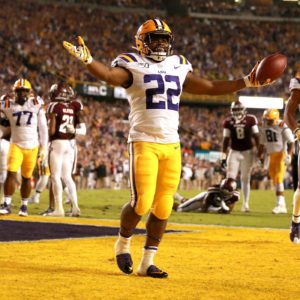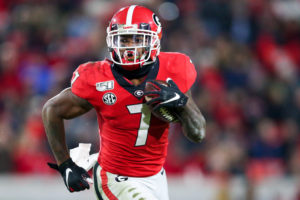Can We Trust Rookie Running Backs In 2020 Fantasy Leagues?
In my most recent article, I took a trip down a Ronald Jones rabbit hole that had started with research on rookie running backs drafted since 2010. Now that I’ve finished taking Jones wherever I can get him, I’m back in the fresh air and back in to the rookies. My goal here is to understand how risky it is to draft rookie running backs in fantasy and what to do with this 2020 class.
I promise that if I get distracted by another rabbit hole, I’ll make a note and come back to it. I WILL get to a conclusion on the rookies first!
The Parameters
For this exercise, I’ve looked at all running backs drafted in the first two rounds of the NFL draft since 2010. That’s a sample size of 44. I’ve then split this exercise in to four distinct areas: the first half of round one (picks 1-16), the second half of round one (picks 17-32), the first half of round two (picks 33-48), and the second half of round two (picks 49-64).
For clarity, everything here is PPR.
See Where The 2020 Rookie Running Backs Fall In Our Fantasy Rankings!
Total Points
Firstly, let’s look at the percentage of picks that gave RB1, RB2 and RB3 performances.

The first takeaway is clear. If a player was deemed worthy of a top-16 pick in the NFL draft then they have a very good chance of being worthy of investment, with 67-percent giving you an RB1 result across their rookie year.
That’s probably not a surprise to most. If a team is using a high first-round pick then they’re going to be thrust into action and given every chance to succeed early. We’re talking about players like Saquon Barkley, Ezekiel Elliott, Christian McCaffrey and Todd Gurley.
The next takeaway for me is that those picked later than the mid-first are very unlikely to give you an RB1 performance in their rookie year and a little under half of them aren’t even going to give you RB3 performances.
What’s that I hear you cry? Wouldn’t these numbers be impacted by the rookies needing to ramp-up and earn their role before they have an impact?
Well that’s what I thought! So let’s look separately at the first half of the year and the second half of the year for each tier of players.
Elite tier
I can’t keep calling them ‘the running backs selected in the first half of round one’ so I’ll call them the Elite Tier.

We can see here that the first half of the season for these guys is similar to their full season production. A good portion of them are going to give you RB1 production through the first half of the year. But what we also see is that the second half drops off.
What this tells me is that they hit early and their first half of the season bolsters their full season numbers, but in the second half of the year when you need them for the fantasy playoff run the chances of them giving you those RB1 numbers drop below half. That’s a concern, and not what you’re expecting when you invest the draft capital needed to snag them.
Stat to know – 78-percent of the players in this category scored less points in the second half of the year than they did in the first half.
Late Round One

In this category, the full season numbers suggest a greater than 50-percent chance of RB3 numbers and only just below that mark for RB2 numbers. But look at those splits. Only 14-percent gave us RB3 or better down the stretch, and that was the muscle hamster himself Doug Martin. No other player drafted in this range has hit RB3 level in the second half.
Another key name in this section is Josh Jacobs. His full year number looks good and his first half was great, but again he didn’t hit the numbers at the back end of the year and wasn’t there for us when we needed him.
Stat to know – 71-percent of the players in this category scored less points in the second half of the year than they did in the first half.
Top of the Second

The second half performances again leave a lot to be desired and now we’re also risking a less than 50-percent chance of even hitting RB3 numbers in the first half of the year. This story reads similarly to the previous batch, except we don’t quite get any player hit the full season RB1 either.
Nick Chubb represents your second-half RB1 performance of note for this group, and whilst his talent was unquestioned it took a Carlos Hyde trade for him to hit those highs.
Stat to know – 82-percent of the players in this category scored less points in the second half of the year than they did in the first half.
That drop-off is getting scary now!
The Back-End
Ok, that category naming might be a bit cruel…

What do these numbers mean? They mean that your chances of getting a top performer in this range are low but they are likely to give you consistent numbers across the year (albeit consistently low!). If you can get them for the right value, these are your flex plays that offer some breakout upside if something happens on the depth chart around them (think Miles Sanders last year).
Generally, the numbers don’t look great here either but what they do show is some consistency. There isn’t that big first half vs second half discrepancy like the other categories.
Stat to know – 29-percent of the players in this category scored less points in the second half of the year than they did in the first half. That makes sense with what we saw above – a lower base but a more stable one with less drop-off.
What that theoretically tells us to do
Some interesting findings here, so what does that theoretically tell us to do?
It tells us to trust in the Elite guys in their rookie years (those drafted in the first half of round one) but look out for signs of a drop-off towards the end of the year. It would be a brave person to trade away a high-functioning rookie RB during a playoff run but if there are signs of decline then history tells us it may be worth a shot.
It’s also telling us that the rest of the rookie class is a risk for year one. I’m sorry, I can spin it whatever way you want me to spin it but that’s the truth. And whatever level of risk you’re willing to take, that risk increases when you’re on the home stretch.
I know that some people are reading this and backing their abilities to work the waiver wire to fill in for that decline at the end of the year (rookie back for the first half, waiver wire back for the second half). That’s fine. Good luck. But if you’ve invested early draft capital in one of these guys and are getting a reasonable return early, how long are you going to keep playing them before you decide to play a waiver-wire pickup over them?
SuperFlex/2QB Dynasty Rookie Rankings (2020)
And how early do you want to draft a player that’s more likely than not to drop off part way through the year?
I recently posted a poll on twitter that combined the late first/early second players, and basically posed the question “where would the fantasy public be willing to take a player with an 11% chance of an RB2 performance down the stretch”.

73-percent of people would take their chance at RB25 or later. That makes sense. By that part of the draft we’re in to some risky picks anyway (Kareem Hunt, Raheem Mostert, James White, etc). So why not take the risk on some rookies.
That’s not to say these players definitely won’t succeed, and at the right value that risk is completely worth the shot on a player you believe in. But buyer beware.
The 2020 Rookies
Let’s look at the 2020 Rookies and where they fit in to the above categories.
Clyde Edwards-Helaire

As I raced towards my conclusion on this theory, Damien Williams opted out of the 2020 NFL season and the twitter-verse lost its collective mind. It also caused me to stop and revisit the impact on what I’m saying here.
The stats:
- pick 32 of the 2020 NFL draft (that’s in our second category “Late Round One”)
- 14-percent chance of being an RB3 or better in the second half
- Based on the initial reaction to the Williams news, CEH is now going somewhere between RB5 and RB8 for most of the experts
He is now the clear-cut RB1 for one of the best offenses in the NFL and his chances of being a high-scoring rookie have just gone through the roof. I can’t in good conscience say that he should be considered as only having a 14-percent chance of being an RB3 in the second half of the season. He could be the 14-percent. He could be Doug Martin.
BUT I do remind you that 71-percent of rookie running backs in this range drop in production from the start of the year to the end of the year. That should still give pause for thought on whether CEH is really going to be a guaranteed hit.
D’Andre Swift

- pick 35 of the 2020 NFL draft (that’s in our third category “Top of the Second”)
- 18-percent chance of being an RB3 or better in the second half
- RB30 in current FantasyPros ECR
Jonathan Taylor

- pick 41 of the 2020 NFL draft (“Top of the Second”)
- 18-percent chance of being an RB3 or better in the second half
- RB23 in current FantasyPros ECR
Cam Akers

- pick 52 of the 2020 NFL draft (that’s in our fourth category “The Back End”)
- 24-percent chance of being an RB3 or better in the second half
- RB28 in current FantasyPros ECR
JK Dobbints

- pick 55 of the 2020 NFL draft (“The Back End”)
- 24-percent chance of being an RB3 or better in the second half
- RB40 in current FantasyPros ECR
AJ Dillon

- pick 62 of the 2020 NFL draft (“The Back End”)
- 24-percent chance of being an RB3 or better in the second half
- RB57 in current FantasyPros ECR
Conclusion
Am I trying to say we shouldn’t draft these guys? No, I’m not saying that.
Am I trying to say that Taylor definitely won’t win fantasy leagues in 2020? No, I’m not saying that either.
What I am saying is that we should be wary of the rookie running backs, and we should be very wary of their draft price. Yes, some of these guys still have massive upside and could win leagues. But history tells us that rookie running backs drafted outside of the top 16 don’t have a great track record in their first year.
And while we look back at full-season numbers with some optimism, it is a risky business to invest draft capital in a position that has historically under-performed when you need them the most.
As the fantasy public has voted, most of us would be happy taking those players sometime after RB25. At RB23, Taylor is somewhere in that ball-park but don’t be surprised if his ADP creeps up before the start of the season. If and when it does, be careful about drafting him close to his ceiling.
As for CEH, well I’m definitely considering him in the back-half of round one now that his path to production has parted like the red sea. But I’m not banking on him being my hero at playoff time.






